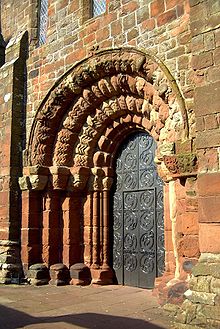- Bega (Cumbria)
-
Die Heilige Bega (auch Bees) war eine irische Königstochter des 7. Jahrhunderts, die zur Zeit von St Hilda von Whitby lebte.
Inhaltsverzeichnis
Leben
 Klosterkirche von St Bees, normannisches Westportal
Klosterkirche von St Bees, normannisches Westportal
Bega hatte sich zum Christentum bekehrt und insgeheim gelobt, Nonne zu werden, worauf ihr ein Engel ein Armband mit einem Kreuzeszeichen überbrachte. Ihr Vater wollte sie jedoch mit dem Sohn des Königs von Norwegen vermählen. Sie segelte deswegen auf einem Erdklumpen von Irland nach Cumbria, wo sie als Eremitin im späteren St. Bees lebte. Später siedelte sie wegen der Bedrohung durch die Dänen nach Northumbria über und gründete schließlich ein Kloster in Copeland. Dieses wurde von den Dänen niedergebrannt, aber kurz nach 1120 als Benediktinerkloster wieder aufgebaut. Es war eine Dependenz des Klosters St. Mary in York. Heinrich VIII. löste das Kloster am 16. Oktober 1539 auf. Das Armband der Heiligen, das sie in Cumbria zurückgelassen hatte, wurde in der Kirche von Copeland verehrt, aber 1216 oder 1315 von plündernden schottischen Horden gestohlen. Ob es sich bei später erwähnten Stücken um das Original oder eine Kopie handelt, ist daher unklar.
St. Bega werden zahlreiche Wunder zugeschrieben. So wurde das ihr zugesprochene Land während eines Rechtsstreits von Schnee verschont und so gekennzeichnet.
Quellen
Eine Vita der Heiligen Bega, Vita et Miracula S. Bege Virginis in Provincia Northanhimbrorum aus dem 13. Jahrhundert stammt aus der Abtei Holmcultram.
Weiterleben
Der Festtag von St. Bega ist der 6. September. Aber auch der 31. Oktober und der 17. Dezember werden in den Quellen erwähnt.
- Das Dorf St. Bees in Cumbria ist nach der Heiligen benannt
- St. Bees’ Head in Cumbria ist nach der Heiligen benannt
- ein Gedicht von William Wordsworth (Stanzas suggested in a Steam-Boat off St. Bees Heads, on the coast of Cumberland) beschreibt unter anderem das Wirken von St. Bega und ihrer Gemeinschaft: sie unterstützten Reisende und geleiteten sie zu ihrem Ziel, rodeten Wälder, halfen den Armen, lehrten das Sakrament und milderten feudale Willkür.
Literatur
- Peter J. Manning: Wordsworth at St. Bees: Scandals, Sisterhoods, and Wordsworth’s Later Poetry. English Literary History 52/1, 1985, 33-58.
- G. C. Tomlinson (trans.): Life and Miracles of Sancta Bega. Carlisle 1842
- John M. Todd: St Bega - Cult, Fact and Legend. Transactions of the Cumberland and Westmorland Antiquarian and Archaeological Society 80, 1980.
Weblinks
Wikimedia Foundation.
